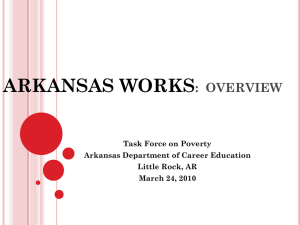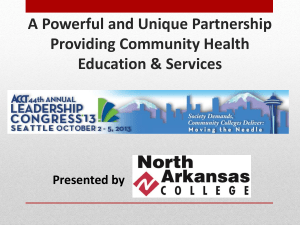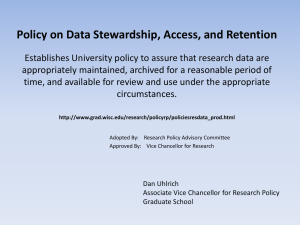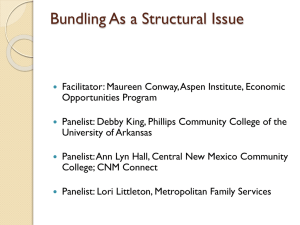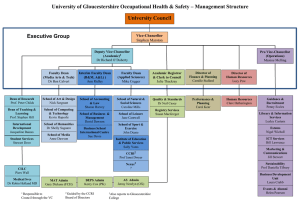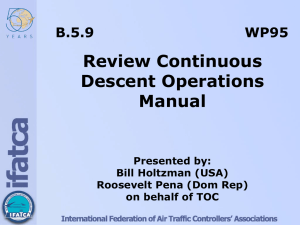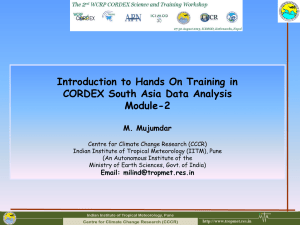September 2 PowerPoint
advertisement
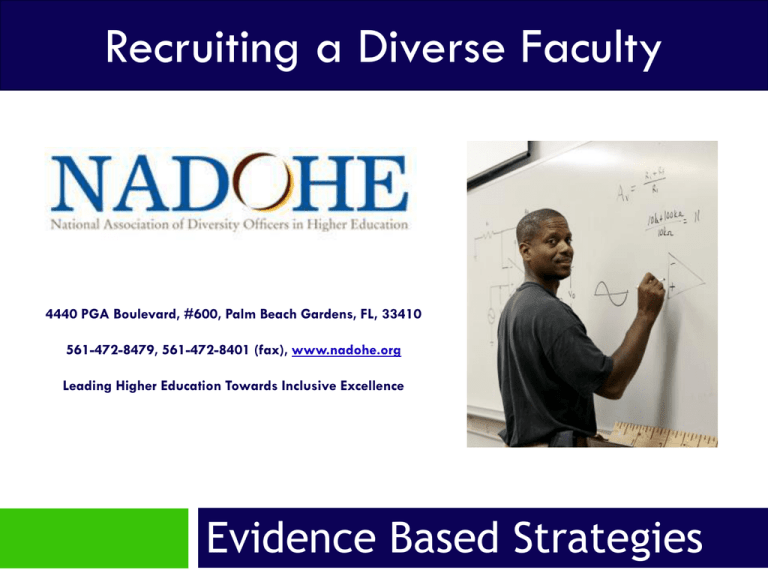
Recruiting a Diverse Faculty 4440 PGA Boulevard, #600, Palm Beach Gardens, FL, 33410 561-472-8479, 561-472-8401 (fax), www.nadohe.org Leading Higher Education Towards Inclusive Excellence Evidence Based Strategies Webinar Logistics Moderator: Dr. Juan Sanchez Munoz Vice President for Institutional Diversity and Community Engagement Associate Vice Provost, Faculty and Undergraduate Academic Affairs Welcome Series Information Format PowerPoint Q&A Technical Difficulties Speakers Dr. Abbie Robinson-Armstrong Vice President for Intercultural Affairs Loyola Marymount University/LA arobinso@lmu.edu Dr. Glen Jones Executive Assistant to the Chancellor for Diversity Senior Associate Vice Chancellor Academic Affairs and Research Arkansas State University gjones@astate.edu Goals Identifying recent demographic trends Understanding how to define faculty objectives Identifying key elements for diversifying the faculty Understanding the role of the Chief Diversity Officer in diversifying the faculty Understanding how to institutionalize strategies to diversify the faculty Developing instruments to measure the efficacy of recruitment strategies Demographic Trends Total Faculty by Ethnicity 1998-2007 90% 80% 70% 60% African American 50% Asian American 40% European American Latino 30% 20% 10% 0% 1998 2003 2005 2007 Source: US Department of Education, National Center for Education Statistics, 1993, 1999, 2004, National Study of Postsecondary Faculty Chronicle of Higher Education, Almanac of Higher Education, 2009 US Department of Education, National Center for Education Statistics, Integrated Postsecondary Education Data System (IPEDS), Winter 2005-2006/2007-2008 Total Faculty by Gender 1998-2007 80% 70% 60% 50% Female 40% Male 30% 20% 10% 0% 1998 2003 2005 2007 Source: US Department of Education, National Center for Education Statistics, 1993, 1999, 2004, National Study of Postsecondary Faculty Chronicle of Higher Education, Almanac of Higher Education, 2009 US Department of Education, National Center for Education Statistics, Integrated Postsecondary Education Data System (IPEDS), Winter 2005-2006/2007-2008 Total Faculty by Discipline 90% 80% 70% 60% Humanities 50% Natural Sciences 40% Social Sciences 30% All Other Fields 20% 10% 0% African American Asian American European American Latino Source: US Department of Education, National Center for Education Statistics, 2004 National Study of Postsecondary Faculty Total Faculty by Gender and Discipline 80% 70% 60% 50% Female 40% Males 30% 20% 10% 0% Humanities Natural Sciences Social Sciences All Other Fields Comments & Questions Academic Case: Diversifying the Faculty Academic Case: Diversifying the Faculty Impact Helps on Institutional Capacity colleges and universities fulfill the mission of higher education Enhances an institution’s academic reputation Adds multiple perspectives, theories and approaches to scholarship and the curriculum Helps institutions achieve excellence in research, teaching and service Helps institutions recruit a diverse student population Academic Case: Diversifying the Faculty Impact on Student Learning and Citizenship Outcomes Increases student retention and persistence Helps institutions prepare students for a global reality Comments & Questions Key Elements For Diversifying the Faculty Key Elements for Diversifying the Faculty Commitment from Senior Level Administrators Transparent and consistent hiring policies and procedures Diverse Search Committee Key Elements for Diversifying the Faculty Training for faculty on legal and ethical principles for conducting a search Internal accountability initiatives that link diversity to academic excellence Availability data Key Elements for Diversifying the Faculty Mission-and culturally-sensitive position announcement Diverse applicant pool Inclusive campus visit Comments & Questions Role of the Chief Diversity Officer Role of the Chief Diversity Officer Understand the culture of the university, the faculty, and each academic unit Ensure your President/Chancellor supports diversity recruitment and retention in its entirety Know exactly what you are trying to achieve. Know your possibilities Role of the Chief Diversity Officer Treat Everyone fair and equitable Prepare new faculty for success Articulate the differences between affirmative action and diversity Role of the Chief Diversity Officer Know the hiring process intimately, monitor it frequently Build Trust and credibility throughout the campus community Know when to step into a situation and when to step out Comments & Questions Applying Research to Practice Loyola Marymount University/LA Comprehensive, Private University Founded in 1911 in Los Angeles, CA Largest Catholic university on the West Coast Equal Opportunity Employer Mission: The encouragement of learning, the education of the whole person, the service of faith and the promotion of justice Loyola Marymount University/LA Degree Seeking Students, Fall 2008 Undergraduate Students Graduate Students Law School Students TOTAL 5,509 1,962 1,374 8,845 Loyola Marymount University/LA Degree Seeking Students by Ethnicity African American American Indian/Alaskan Native Asian/Pacific Islander Hispanic/Latino European American International Unknown 8.2% .6% 12.3% 20.2% 56.3% 2.3 % .1% Loyola Marymount University Full-Time Tenured and Tenure Track-Faculty by Ethnicity, Fall 2008 African American 8% Asian/Pacific American 10% European American 71% Latino 11% Minority Faculty 29% European American Faculty 71% Search Committee Training Part I Best Practices for Recruiting Faculty for Mission Participants: Faculty who have not participated in a Search Committee Length: Two-hours Invitee: President Presenters: Diversity Officer & Vice President for Mission and Identity Part II Moving Beyond Traditional Search Strategies Participants: Search Committee Chairs Length: Two-hours Invitee: President Presenters: Diversity Officer, Vice President for Mission and Identity and Faculty Search Committee Training Part I Part II Best Practices for Recruiting Faculty for Mission Moving Beyond Traditional Search Strategies Goals Goals Enroll in institutional mission Shape faculty perceptions about diversity Understand recruiting faculty for mission Understand Best Practices for Search Committees Understand legal and ethical principles for executing a search Understand how unconscious bias and exclusionary thinking impacts search results Identify a transparent process for conducing searches Part II Moving Beyond Traditional Search Strategies Requisite Responsibilities for Pro-active Search Committees Composition of the Search Committee Pro-Active Versus Traditional Search Committees Advocates for institutional mission, minorities and women (Handout Number 1) Part II Moving Beyond Traditional Search Strategies C o n t e n t s Legal Principles Validity Objectivity Measurable Consistency Patterned Interview & Uniform Reference Check Third Party Explanation Confidentiality Documentation Part II Moving Beyond Traditional Search Strategies C o n t e n t s Ethical Principles Myths about Minority Faculty Availability Exclusionary Thinking Halo Effect Determine Who is Qualified: Judge What’s on Paper Chilly Climate Issues Respect of Candidate’s Dignity and Self Worth Reviewing Applicants: Research on Bias and Assumptions (Women in Science & Engineering Leadership Institute, University of Wisconsin) Part II Moving Beyond Traditional Search Strategies C o n t e n t s Report on Assessment of the Department Review: LMU Strategic Plan College and Department Strategic Plans LMU Profile of the Faculty College Equity Scorecard Survey of Earned Doctorates (Tables 2&3) Align Department and Institutional Commitments (Handout Number 1) Part II Moving Beyond Traditional Search Strategies C o n t e n t s Proactive Recruitment Plan Expand Recruitment Sources Mission and Culturally Sensitive Position Announcement (Handout Number 2) Language that Attracts Minority and Women Candidates Links Diversity to Academic Excellence Part II Moving Beyond Traditional Search Strategies C o n t e n t s The Short List Gender can influence perceptions of the quality of a curriculum vitae (University of Toronto; University of Wisconsin) There are numerous ways to describe valuable contributions to a discipline Cultural differences reflected in a curriculum vitae or letter of references can influence evaluators (University of Toronto) Part II Moving Beyond Traditional Search Strategies C o n t e n t s The Short List Scholars with non-standard career paths can make excellent contributions that are similar to individuals whose career paths have been less complex, e.g. a scholar with a complex medical, law or business history or family responsibilities, or a tie to a specific geographic and historic community (University of Toronto) Part II Moving Beyond Traditional Search Strategies C o n t e n t s The Short List Make multiple short-lists based on different criteria established helps to ensure diversity. If three of the criteria are teaching, research and service, create short-lists that rank applicants within these categories (University of Toronto) Part II Moving Beyond Traditional Search Strategies C o n t e n t s Inclusive Campus Visit Contact candidates in advance to answer questions, allay concerns and express excitement about impending visit Provide opportunities for candidates to meet with faculty who have similar scholarly and professional interests Monitoring the Search Process Search Committee Chair meets with Deans throughout the process Search Committee hold one meeting with the Vice President for Intercultural Affairs and the Vice President for Mission and Ministry Evaluation of the Search Process On-line survey completed by the Search Committee as a Team (Handout Number Three) Measures efficacy of the search process Helps to explain Search Committee’s perceptions about faculty diversity Generates empirical evidence that helps faculty determine how to improve the faculty search process Retention Initiatives and Programs Handout #4 Loyola Marymount University/LA Faculty Profile LMU Ethnicity Index Latino European American Series1 Asian American African American 0% 50% 100% 150% Comments & Questions Applying Research to Practice Arkansas State University Founded in 1909 in Jonesboro, Arkansas 70 miles NW of Memphis, TN Comprehensive public, regional university Transitioning to research intensive status Only 4-year institution in the Arkansas-Mississippi Delta Comprehensive Affirmative Action/Equal Opportunity Employer Mission: Arkansas State University educates leaders, enhances intellectual growth, and enriches lives. (ASU = e3) Applying Research to Practice Arkansas State University Below Southern Regional faculty salary averages at all levels Subject to Arkansas’s “line item maximum” rule Comprehensive Affirmative Action/Equal Opportunity Employer Mission: Arkansas State University educates leaders, enhances intellectual growth, and enriches lives. (ASU = e3) Diversity’s Impact: Managing Change COMPONENTS OF CHANGE INDIVIDUAL ATTITUDES & BELIEFS CHANGE ORGANIZATIONAL VALUES & POLICIES EXECUTIVE COUNCIL MANAGEMENT SKILLS & PRACTICES Training and Development Arkansas State University: Student Information Undergraduate Students Graduate Students Total Students 9,764 1,726 11,490 Arkansas State University: Ethnicity of the Student Population African American International* Hispanic/Latino White/Caucasian 18.2% 3.5% 1.0% 77.3% Arkansas State University: Ethnicity of the Faculty African American International Hispanic/Latino White/Caucasian 9.0% 4.3% 1.0% 85.7% Historical Faculty One-Year Retention Rates Historical ASU Faculty One-Year Retention Rates 100% 80% 60% 40% 20% 0% 1998 - 1999 1999 - 2000 2000 - 2001 2001 - 2002 2002 - 2003 All Faculty 2003 - 2004 2004 - 2005 Minority Faculty 2005 - 2006 2006 - 2007 2007 - 2008 Arkansas State University: Background Information C o n t e n t s Facilitative Approach to Diversity Initially No Dedicated Budget This was by design Administrative Assistant Campus Engagement? Significant time building personal relationships Clearly articulate where we want to go and why? Vice Chancellors, Deans, Chairs Faculty Arkansas State University: Background Information C o n t e n t s Facilitative Approach to Diversity Total Dependence on Others Taskforce; Identify Standing Committee Champions (10%), Understand Outliers (10%), Influence Fence-Sitters (80%) Create a vision. Chart a course. Maintain your focus. Accept your limitations. Know your campus. Employment in Words and Pictures Retooling Opportunity Identification Recruitment Employment Retention Celebrate Successes: Large and Small Successes Fall 2008 Record number and percentage of faculty of color (67, 14.3%) up 76% over Fall 2002 (38, 8.8%) Record number of staff of color (137, 14.2%*); up 48% over Fall 2002 (92, 10.8%) Total employees of color is up 57% to 204 employees representing 14.2% of the full-time employee base compared to 130 employees (9.9%) in Fall 2002. Celebrating Successes Spring 2009 Tenure and Promotion Extended to Two African American Females (First African Americans to Earn Tenure since 2002) African American Female Promoted to Full Professor Seven female department chairs Managing Transition New Chancellor (2006), New Provost (2008) CDO Chairs both searches Dean Provost (2008) Dean Retirement (2 -2008) Chair Dean Dean Dean Faculty Member Chair (Research Institution) 2002-2005 – Key Retirements The Search Process Justification for Initiating a Search Must be approved by Vice Chancellor Once approved, must complete the “Search Process Document” Diverse representation on committees Drafting the position announcement Requirements vs. Preferences Placement of the announcement Recruitment efforts to be undertaken to identify diverse candidates Criteria to be utilized in screening and evaluating candidates The Search Process: Timing Is Everything Position announcement can’t be posted until CDO approves CDO meets with search committee Proactive Nature of the Search Chair or Dean Authorize to Make Offer Resources Available Legal Matters “Dos and Don’ts” Role CDO will play in recruitment process The Search Process Pre-Interview Statement Completed prior to the beginning of interviews. Qualified diverse candidates in the pool, but will not be interviewed. Reasons for not granting interviews must be articulated to CDO. Search process stops if document not completed. The Search Process Post-Interview Statement Completed after the interview process, but before any offer can be made. Qualified diverse candidates interviewed, but will not be extended an offer. Reasons for not extending an offer must be articulated to CDO (Typically, comes from the Dean). Search process stops if document not completed. The Search Process Recruitment Summary Form Completed CDO approves the offer (after Dean has) and contract is requested. Supporting The Search Process Recruitment Funds Ad Placement Travel to Recruit Support to bring in “additional” candidates Interview Support Participation in Interview Process Hosting candidate receptions Introduce to members of the campus and community Allows candidate an opportunity to ask “real” questions. Affirm the committees work in real time. Supporting The Search Process Negotiation Support Advice offered during negotiations to prospective faculty (start-ups, reassigned time, start dates, etc.) Advise Chair or Dean regarding offers and counteroffers Hiring Support Salary Support Trailing Spouse Support (Retention) Moving Support Salary Compression/Equity Issues References: New Professionals Perfect candidates do not exist. Must be willing to extend opportunities to non-perfect individuals. References are important, but the committee must make its own assessment about the person’s abilities. All Ph.D. students do not receive the same level of mentoring or equal opportunities to participate in research projects with faculty. Remember, many of us were once new faculty members. Think about it. Everyone wants to hire the “Stars,” but few are willing to invest in such individuals early in their careers. Monitoring the Search Process How do you know who is in your applicant pool? What is your process for managing and monitoring searches? ASU – All searches are conducted online and all processes discussed above are completely web- based. https://jobs.astate.edu/ PeopleAdmin Multi-user system that tracks searches from beginning to end Generates hiring data which supports trend analysis Recruiting a Diverse Faculty: Accountability Each Vice Chancellor is Expected to contribute to the efforts of diversity. Contribution to Diversity a Component of Evaluation of Each Dean Arkansas requires the filing of annual updates to each institution’s “Minority Retention Plan.” The Board of Trustees wants a campus that is reflective of the student body and the state of Arkansas. Product of the state’s Legislative Black Caucus Retention Efforts Quality Teaching and Learning Circle Promotes excellence in teaching, research and service among faculty members by creating positive and safe environments to exchange ideas, receive enriching criticism, express concerns and access a university-wide support system. Led by for Chair of University’s Promotion, Retention, and Tenure Committee Retention Efforts Connect individuals to the community Church/Religious Institution Community Service Organizations, etc. Fellowships Large-group Fellowships Personal dinner invitations Engagement with Dean and Chair Professional Development Opportunities Progress on Promotion and Tenure Special Needs The Path Ahead: Institutionalizing Diversity Hiring University Core Values Culture Student and Community Engagement International Recognition as Diversity Leader Comments & Questions Contact Information Dr. Abbie Robinson-Armstrong arobinso@lmu.edu Dr. Glen Jones gjones@astate.edu



